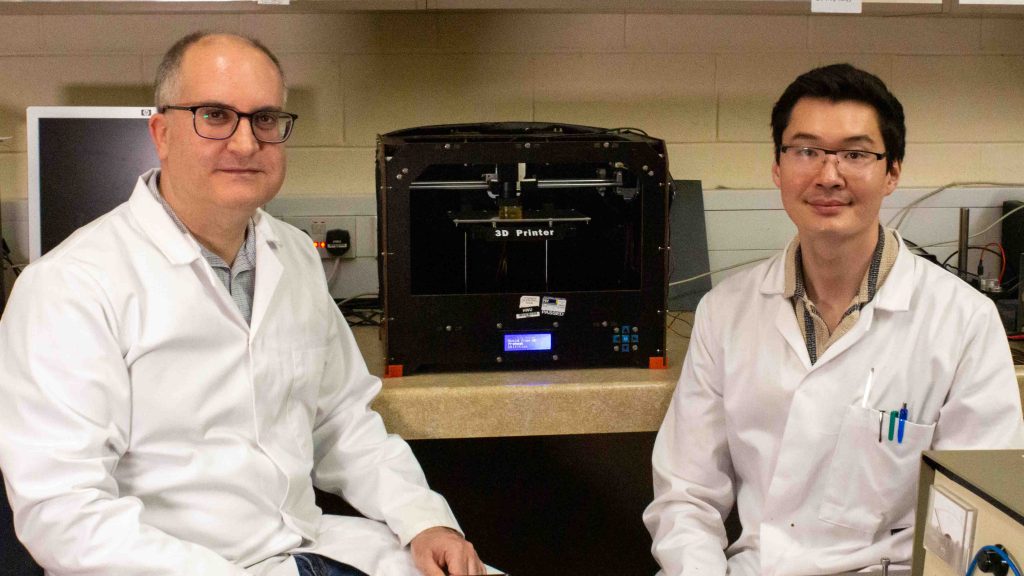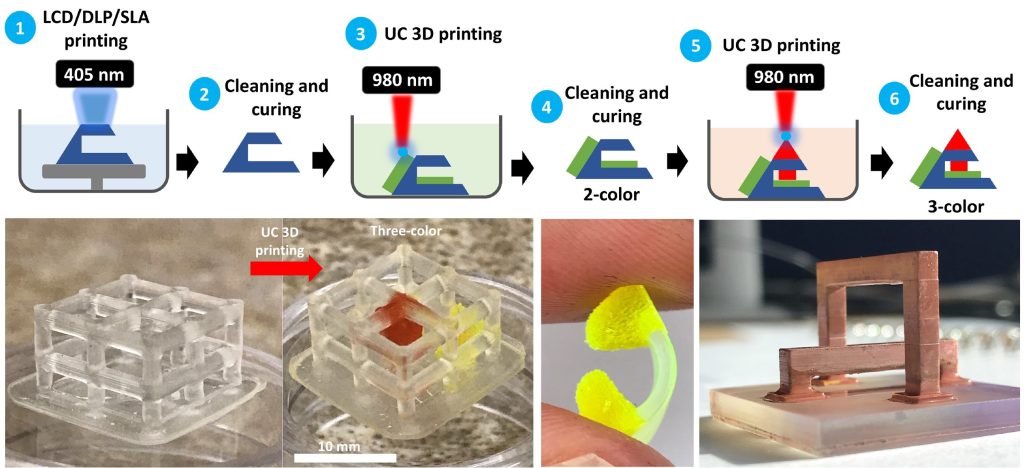Scientists from Edinburgh’s Heriot-Watt University have developed a new method that uses near-infrared (NIR) light to 3D print complex structures with multiple materials and colors. Dr. Jose Marques-Hueso led the research from Heriot-Watt’s Institute of Sensors, Signals & Systems.
The team modified the widely-used stereolithography (SLA) 3D printing process to achieve greater multi-material integration.
Traditional SLA 3D printing applies a blue or UV laser to a liquid resin, which is selectively solidified layer by layer. However, this process lacks material intermixing capabilities. Through this new process, the scientists employed a NIR light source capable of 3D printing into the resin vat at greater depths. The scientists claim that this novel process offers significant potential for 3D printing specialist parts, particularly within the health and electronics sectors.
This is not the first 3D printing process to enable multi-material 3D printing. Indeed, Fused Deposition Deposition (FDM) has long offered capabilities for 3D printing with multiple materials. However, the scientists claim that their new method allows for producing multi-material parts at much higher resolutions.
According to Dr. Adilet Zhakeyev, a Ph.D. researcher at Heriot-Watt University who has worked on the project for nearly three years, “Fused Deposition Modelling (FDM) technology was already able to intermix materials, but FDM has a low resolution, where the layers are visible, while light-based technologies, such as stereolithography, can provide smooth samples with resolutions under five micrometers.”
The project, titled ‘Multimaterial Stereolithography by Crosslinking through Luminescence Excitation,’ has received £280,000 in funding from the Engineering and Physical Sciences Research Council (EPSRC). The team’s findings have been published in the journal Applied Materials Today.

The new NIR 3D printing process
New to this method is the use of NIR invisibility windows of materials to 3D print at depths of over 5 cm, a substantial increase from conventional SLA technology’s 0.1mm depth limit. Dr. Marques-Hueso claims that this method “has never been done before.”
A key benefit of this new process is that it allows users to 3D print a part in one material, adding a second material later on. This second material is not limited to the top and outer surfaces of the 3D printed part and can be solidified at any position in the 3D space. This is because the NIR laser can penetrate through the outer layer of the initial part.
“For example, we can print a hollow cube that is mostly sealed on all sides. We can then come back later and print an object made from an entirely different material inside this box because the NIR laser will penetrate through the previous material as if it were invisible because in fact, it is completely transparent at the NIR,” explained Dr. Marques-Hueso.
According to the researchers, a key component of this project has been the development of engineered resins containing nanoparticles that exhibit optical upconversion. These nanoparticles absorb the NIR photons, transforming them into blue photons, which solidify the resin.
This phenomenon is ‘non-linear’, meaning that it can obtain the blue photons mostly at the laser’s focus and not on the way through it. This allows the NIR to penetrate deep into the material as though it were transparent, only solidifying the inner material.
Ultimately, this new process allows multiple materials with different properties to be 3D printed in the same sample. For instance, flexible elastomers and rigid acrylic can be 3D printed together. The scientists point to various applications that this method benefits, including 3D printing inside cavities, shoe production, restoration of broken objects, and in-situ bioprinting through skin.
This process is also notable for its affordability. “A clear advantage of this technique is that the full machine can be built for less than £400. Some other advanced technologies that use lasers, such as Two-Photon Polymerisation (2PP), require expensive ultrafast lasers in the order of tens of thousands of pounds, but this is not our case because our specialist materials allow the use of inexpensive lasers,” said Dr Marques-Hueso.
“Now that we have results to support our claims, we hope to partner with businesses and develop this technology further,” added Dr Marques-Hueso.

Multi-material resin 3D printing
The Heriot-Watt approach is not the first process to enable multi-material resin 3D printing. Last year, Barcelona-based 3D printer manufacturer BCN3D unveiled a new Viscous Lithography Manufacturing (VLM) 3D printing technology. Researched and developed over three years, this technology offers dual-material resin 3D printing capabilities, allowing users to 3D print two different resins in a single build.
BCN3D’s multi-material resin offering uses a UV light engine and LCD screen. Unlike most LCD 3D printers, this system leverages a special mechanical system that laminates resin onto a film. This film is transported to the build area where the resin is cured, transferring from the film to the part on the build plate. Because the VLM resins can be laminated and cured on two different films, it’s possible to combine two resins for multi-material parts and soluble support structures.
Last year, Dr. Adrian Bowyer, the founder of RepRap, proposed a new method for SLA multi-material 3D printing. Bowyer’s method includes 3D printing the first layer in resin A, which is then poured away. Resin B is then added to 3D print the first layer again. Next, the second layer is 3D printed with resin B. This resin is then poured away, and the layer 3D printed again in resin A. By repeating this process, Bowyer claims that each layer could be 3D printed with two different materials.
Subscribe to the 3D Printing Industry newsletter to keep up to date with the latest 3D printing news. You can also follow us on Twitter, like our Facebook page, and subscribe to the 3D Printing Industry Youtube channel to access more exclusive content.
Are you interested in working in the additive manufacturing industry? Visit 3D Printing Jobs to view a selection of available roles and kickstart your career.
Featured image shows Dr Jose Marques-Hueso. Photo via Hariot-Watt University.


